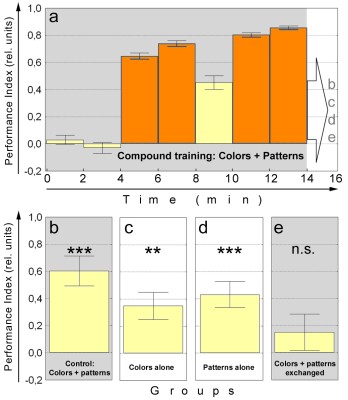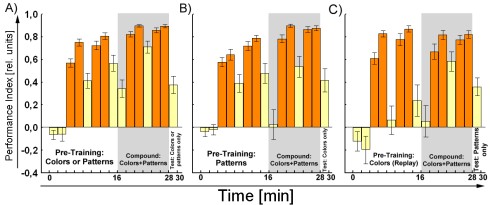|
As described in the background section on the features of classical conditioning, blocking is one of the critical phenomena for a theory of learning based on predictability. To my knowledge, blocking experiments in insects have only been conducted in bees so far. Blocking in insects in an operant paradigm has not been described, yet. These are the results of a blocking experiment using Drosophila in the flight simulator with patterns and colors as conditioned stimuli (CS) and heat as the reinforcer or unconditioned stimulus (US). To control for the required independent processing of two CSs when they are presented in a compound, the coloration of the arena (CS2) was changed whenever the fly brought one of the two pattern orientations (CS1) into its frontal visual field (a, compound training, CS1+CS2+US). In the subsequent test phase, either no change was made in the setup (b, control), or the patterns were replaced by four identical vertical bars (c, colors, CS2 alone), or the color filter was removed (d, patterns, CS1 alone), or the pattern orientation associated with one color during training was reversed (e, nonsense CS). If similar positive scores in both CS alone tests and no learning in the nonsense CS test are obtained, it is concluded that no overshadowing occurred between the two CSs and both are learned equally well when presented in a compound.
 After compound training of colors and patterns, either the training compound (b), or colors alone (c) or patterns alone (d) were tested. In both cases, significant learning scores were obtained, which could not be distinguished from each other statistically. To control for a direct overshadowing effect of one CS over the other, the relation between colors and patterns was reversed (i.e. if one pattern - e.g. the upright T - was paired with one of the colors - e.g. green - during training, the relation is reversed - e.g. upright T and blue) in the final test phase (e). No CS seemed to acquire a stronger associative strength when the other was present. Orange bars - training; yellow bars - test. This result suggests that the total amount of overshadowing (i.e. an effect of different salience of the two stimuli) is very small and statistically not reliable. Had there been a substantial amount of overshadowing, one would have expected a deviation from zero towards the more salient stimulus. Following a standard blocking procedure, the first CS was pre-trained to the maximum extent, then a compound training of equal duration followed. To assure the predictive value of the pre-trained CS, an intermitting test for the compound CS was introduced before the compound training. Additional controls were balanced for CS and US presentations.
 In contrast to current learning theory, operant pre-training of one CS did not diminish the associative strength a second CS acquired when trained in compound with the first (A). The controls (B, C) are balanced for CS and US presentations and differ from the test group in the low predictive value the compound CS obtained (first test bar in the area shaded gray). No significant difference was found between test and control groups. Specifically, in no instance were the learning scores in the blocking groups lower than in either control groups or the respective CS processing groups. In our blocking experiment, there is a very obvious carry-over from the pretraining to the compound pretest as well as extremely high avoidance, indicating that the US is already very well predicted, when the patterns are introduced. Nevertheless, there is a significant learning score when only the second CS is finally tested after the compound training. This is at odds with all modern learning rules and still demands clarification. Do insects learn according to other rules than vertebrates? Is it an experimental artifact? Is operant so different from classical conditioning that error-correcting learning rules do not apply? In the meantime we have repeated this blocking experiment with just 4 minutes of compound training and control groups that lacked the US experience, but changing these variables (known to affect blocking results in vertebrates) had no efect either: there was no difference between blocking and control groups (data not shown) It will be extremely interesting to find out whether we will obtain the same results when we train the animals classically in the same setup. Another critical issue is the sensory preconditioning phenomenon. Will that also yield results contradicting mainstream learning theories? A more detailed discussion of these results s available in our paper "Conditioning with compound stimuli in Drosophila at the flight simulator" (PDF). All content on brembs.net is copyright © Björn Brembs, 2001. |